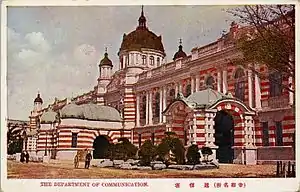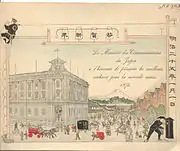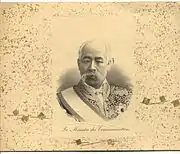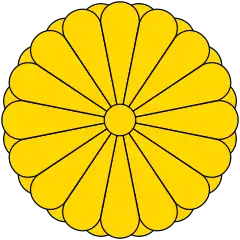| 逓信省 Teishin-shō | |
.svg.png.webp) | |
| Agency overview | |
|---|---|
| Formed | December 22, 1885 |
| Dissolved | April 1, 1949 |
| Superseding agencies | |
| Jurisdiction | |
| Headquarters | Chiyoda-ku, Tokyo, Japan |
| Parent agency | Government of Japan |

The Ministry of Communications (逓信省, Teishin-shō) was a Cabinet-level ministry in the Empire of Japan. Its modern successors include the Ministry of Internal Affairs and Communications, Japan Post and Nippon Telegraph and Telephone
History
Meiji period
On December 22, 1885 the Ministry of Communications was established, combining the Bureau of Posts and Post Station Maintenance and Shipping Bureau formerly under the Ministry of Agriculture and Commerce with the Telegraph Bureau and Lighthouse Management Bureau formerly under the Ministry of Industry. On August 16, 1891, the ministry was also placed in charge of the nascent Japanese electric power industry. On July 21, 1892, the Railway Bureau was transferred to the Ministry of Communications from the Home Ministry and from November 10, 1893, the ministry was charged with the supervision of all land and water transportation businesses.
However, on December 5, 1908, the Railway Bureau was separated to become an independent bureau reporting directly to the Cabinet.
Showa period


In April 1923, responsibility for civil aviation supervision was transferred to the Ministry of Communications from the Army Ministry. With the creation of the Railway Ministry in May 1928, supervision of all land transportation was removed from the Ministry of Communications. With the establishment in January 1938 of the Ministry of Health and Welfare, all matters pertaining to the postal insurance program were transferred to the new ministry, with the Ministry of Communications retaining control of the post offices and managing the postal system (including the Postal savings system. In December 1941, an external Maritime Affairs Council was established and took over the Lighthouse Bureau.
On November 1, 1943 the Ministry of Communications was merged with Railway Ministry to become the Ministry of Communications and Transport. Electrical production and aircraft manufacturing regulation was transferred to the Ministry of Munitions. Posts, telephone and telegraph, post office bank and insurance came under the Communications Institute, where issues relating the transportation came under the Directorate General of Shipping.
In May 1945, the Communications Institute became the Board of Communications, reporting directly to the Cabinet, and the Ministry of Communications and Transport was renamed the Ministry of Transport.
Post-war dissolution
After the surrender of Japan, the American occupation authorities briefly reestablished the Ministry of Communications on April 1, 1946; however it was in charge of only posts, telecommunications and the security of aerial navigation. The Ministry was formally abolished on April 1, 1949 and its responsibilities divided between the new Ministry of Postal Services and Ministry of Telecommunications.
Ministers of Communications
| Name | Cabinet | Date in office | comments | |
|---|---|---|---|---|
| 1 | Enomoto Takeaki | 1st Itō, Kuroda | 22 December 1885 | concurrently Agriculture & Commerce |
| 2 | Gotō Shōjirō | Kuroda, 1st Yamagata, 1st Matsukata | 30 April 1888 | |
| 3 | Kuroda Kiyotaka | 2nd Itō | 8 August 1892 | |
| 4 | Watanabe Kunitake | 2nd Itō | 17 March 1895 | concurrently Finance Minister |
| 5 | Shirane Senichi | 2nd Itō, 2nd Matsukata | 9 October 1895 | |
| 6 | Nomura Yasushi | 2nd Matsukata | 26 September 1898 | |
| 7 | Suematsu Kenchō | 3rd Itō | 12 January 1898 | |
| 8 | Hayashi Yūzō | Ōkuma | 30 June 1898 | |
| 9 | Yoshikawa Akimasa | 2nd Yamagata | 8 November 1898 | |
| 10 | Hoshi Tōru | 4th Itō | 19 October 1900 | |
| 11 | Hara Takashi | 4th Itō | 22 December 1900 | |
| 12 | Yoshikawa Akimasa | 1st Katsura | 2 June 1901 | |
| 13 | Sone Arasuke | 1st Katsura | 17 July 1903 | concurrently Finance Minister |
| 14 | Ōura Kanetake | 1st Katsura | 12 September 1903 | |
| 15 | Yamagata Isaburō | 1st Saionji | 7 July 1906 | |
| 16 | Hara Takashi | 1st Saionji | 14 January 1908 | concurrently Home Minister |
| 17 | Hotta Masayasu | 1st Saionji | 25 March 1908 | |
| 18 | Gotō Shinpei | 2nd Katsura | 14 July 1908 | |
| 19 | Hayashi Tadasu | 2nd Katsura | 30 August 1911 | concurrently Home Minister |
| 20 | Gotō Shinpei | 3rd Katsura | 21 December 1912 | |
| 21 | Motoda Hajime | 1st Yamamoto | 20 February 1913 | |
| 22 | Taketomi Tokitoshi | 2nd Ōkuma | 16 April 1914 | |
| 23 | Minoura Katsundo | 2nd Ōkuma | 10 August 1915 | |
| 24 | Den Kenjirō | Terauchi | 9 October 1916 | |
| 25 | Noda Utarō | Hara, Takahashi | 29 September 1918 | |
| 26 | Maeda Toshisada | Katō Tomosaburō | 12 June 1922 | |
| 27 | Inukai Tsuyoshi | 2nd Yamamoto | 2 September 1923 | concurrently Education Minister |
| 28 | Yoshirō Fujimura | Kiyoura | 7 January 1924 | |
| 29 | Inukai Tsuyoshi | Katō Takaaki | 11 June 1924 | |
| 30 | Adachi Kenzō | Katō Takaaki, 1st Wakatsuki | 30 May 1925 | |
| 31 | Mochizuki Keisuke | Tanaka | 20 April 1927 | |
| 32 | Fusanosuke Kuhara | Tanaka | 23 May 1928 | |
| 33 | Matajirō Koizumi | Hamaguchi, 2nd Wakatsuki | 2 July 1929 | |
| 34 | Chūzō Mitsuji | Inukai | 13 December 1931 | |
| 35 | Hiroshi Minami | Saitō | 26 May 1932 | |
| 36 | Tokonami Takejirō | Okada | 8 July 1934 | |
| 37 | Keisuke Okada | Okada | 9 September 1935 | concurrently Prime Minister |
| 38 | Mochizuki Keisuke | Okada | 12 September 1935 | |
| 39 | Tanomogi Keikichi | Hirota | 9 March 1936 | |
| 40 | Tatsunosuke Yamazaki | Hayashi | 2 February 1937 | concurrently Agriculture & Forestry Minister |
| 41 | Hideo Kodama | Hayashi | 10 February 1937 | |
| 42 | Ryūtarō Nagai | 1st Konoe | 4 June 1937 | |
| 43 | Suehiko Shiono | Hiranuma | 5 January 1939 | concurrently Justice Minister |
| 44 | Harumichi Tanabe | Hiranuma | 7 April 1939 | |
| 45 | Ryūtarō Nagai | Abe | 30 August 1939 | concurrently Railway Minister |
| 46 | Masanori Katsu | Yonai | 16 January 1940 | |
| 47 | Shōzō Murata | 2nd Konoe, 3rd Konoe | 22 July 1940 | |
| 48 | Ken Terajima | Tōjō | 18 October 1941 | |
| 49 | Yoshiaki Hatta | Tōjō | 8 October 1943 | concurrently Railway Minister |
References
- Beasley, W.G. (2000). The Rise of Modern Japan: Political, Economic, and Social Change since 1850. Palgrave Macmillan. ISBN 0-312-23373-6.
- Samuels, Richard J (1996). Rich Nation, Strong Army:National Security and the Technological Transformation of Japan. ornell University Press. ISBN 0-312-23373-6.
- Sims, Richard (2001). Japanese Political History Since the Meiji Renovation 1868-2000. Palgrave Macmillan. ISBN 0-312-23915-7.
- Howe, Christopher (1996). The Origins of Japanese Trade Supremacy: Development and Technology in Asia. C Hurst Publishing. ISBN 185065221X.
- Low, Morris (1999). Science, Technology and Society in Contemporary Japan. Cambridge University Press. ISBN 0521654254.
- "Imperial Ordinance No. 343" (PDF). Official Gazette: English Edition. No. 74. Government Printing Bureau. 1946-07-01. pp. 1–3. Retrieved 2021-03-18.
